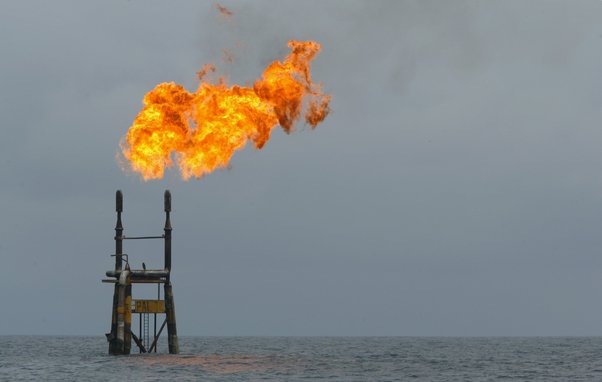Oil and gas producers who signed up to a decarbonisation pact at the COP28 summit last month are set to collectively emit more than 150 billion tonnes of CO2 from their products by 2050, using up over 60 percent of Earth’s remaining 1.5C carbon budget, new analysis shows.
The Oil and Gas Decarbonization Charter was one result of dozens of fossil fuel CEOs attending the crucial climate talks in Dubai. It has been heralded by host the UAE as a big win for the environment, with the deal being “dedicated to high-scale impact, and to speed up climate action within the industry”.
But the charter, which was authored by the same firms that signed on to it and which is entirely voluntary, only commits signatories to “net-zero operations” by 2050. It does not include the end-use emissions associated with burning their oil and gas products. This means that the vast majority – up to 90 percent - of these companies’ true carbon footprints aren’t covered by the pact.
Global Witness used the Rystad Energy database to investigate the oil and gas production plans of the over 50 signatories to the pact, then used industry standard metrics to calculate the total emissions from their products (known as Scope 3 emissions) by 2050 – the year by which the global economy must achieve net zero emissions.
It found that:
- Overall, the companies who signed the pledge are on course to produce 265 billion barrels of oil and 26.7 billion cubic metres of gas by mid-century
- The total emissions from these products will release 156 billion tonnes of carbon dioxide equivalent. That is around 62 percent of the remaining carbon humankind can produce before we exhaust our carbon budget to limit heating to 1.5C
- Of the signatories, the most polluting national oil companies were Saudi Aramco and the Abu Dhabi National Oil Company (ADNOC) with a combined production of 136.4 billion barrels of oil and 5.5 billion cubic metres of gas between them. These two companies alone are projected to produce products that emit 64.7 billion tonnes of CO2 – more than one quarter of the remaining 1.5C budget
- The most polluting international oil companies to sign the pact were ExxonMobil, Equinor, TotalEnergies, Eni and Shell, with a combined production of 57 billion barrels of oil and 8.4 billion cm of gas. Products from these five listed firms will emit 38.6 billion tonnes of CO2. That’s the equivalent of 15 years’ worth of the European Union’s annual emissions
The signatories to the Decarbonization Charter have committed only to achieve net zero emissions from their operations by 2050 – not to decarbonise their entire value chain. End use (scope 3) emissions from oil and gas products account for up to 90 percent of their overall emissions. This means that the companies involved have no announced plans to reduce the vast majority of their carbon footprints.
COP28 came at the end of the hottest year in history and as greenhouse gas emissions and atmospheric CO2 levels also broke records.
QUOTES FROM CLIMATE CAMPAIGNERS
Luisa Neubauer, climate activist and co-organiser of the Fridays For Future climate strike movement, said:
"COP28 has shown that the profits of fossil fuel companies receive more care than the most affected regions of the world. Parts of the COP agreement sound like a Christmas present for the fossil fuel lobby. Compared to what is needed in the hottest year in human history, the COP agreement is not even close to enough. The future will lie primarily in the hands of those who resist new coal, oil and gas projects locally and globally."
Bill McKibben, Schumann Distinguished Scholar, Middlebury College & Co-founder of 350.org, said:
"You'd think the hottest year in the last 125,000 would be enough to end greenwashing once and for all--but since it wasn't, let's state it plainly. No means no--there's not a way to square 'decarbonization' with fossil fuel expansion. They mean the exact opposite.”
Jamie Peters, climate coordinator at Friends of the Earth, said:
“This analysis, while jaw-dropping, only reinforces what we’ve long known - that fossil fuel companies will stop at nothing to extract every last drop of profit from the world’s remaining fossil reserves, no matter the cost.
“Global experts have been emphatic that new fossil fuel projects are incompatible with averting runaway climate breakdown. Yet in the UK alone, we’ve seen the government approving a raft of controversial new developments and opening up hundreds of North Sea oil and gas licences.
“At a time when people all over the world are facing extortionate living costs - with the volatility of global gas and oil markets among the biggest factors driving up prices – and the mounting effects of climate breakdown, the companies fuelling both continue to cash in at our expense. That execs from these very same companies are getting prime access to influential climate talks is so absurd that it hardly registers as surprising. The injustice is breathtaking.”
May Boeve, Executive Director of 350, said:
“The window of opportunity for acting on climate is rapidly closing and we have little time left for hypocritical pledges. When we talk about fossil fuel phase out, we mean all fossil fuels and a fair, fast and equitable transition to renewable sources.
“Oil and gas producers have made their wealth at the expense of people living at the forefront of climate impacts. Instead of using their massive wealth to support the transition to renewable energy that will meet our 1.5C target, the fossil fuel industry tries to sell unproven decarbonization technologies like Carbon Capture and Storage that risks extending the world’s reliance on oil and gas.”
Cara Jenkinson, Cities Manager at Ashden, said:
“This powerful analysis by Global Witness highlights that the operations of the fossil fuel industry make up a tiny proportion of the total carbon emissions from the sector. The only way to slash emissions from usage of oil and gas is to cut demand – governments across the world must speed up their electrification plans, with poorer nations being supported to bypass fossil fuel vehicles and ramp up clean renewable energy production.”
Patrick Galey, senior fossil fuels investigator at Global Witness, said:
“After looking at the detail of this pact, signed to great backslapping by bosses of some of the world’s largest polluters, I have only two questions: Who do these people think they are, and how stupid do they think we are?
“If a child promises to do less than 10 percent of their homework, they don’t get a gold star. So why are oil and gas bosses congratulating themselves for signing up to rules they wrote themselves and which only address 10 percent of their companies’ contribution to the climate crisis?
“The climate, the planet, and the future livelihoods of billions at the coalface of the climate emergency don’t care about clever accounting. This pact is little more than a forgery, publicly committing each company to address its outsize contribution to global heating, while privately allowing them to produce and sell billions of barrels of oil and gas for decades more.”
“How can these CEOs keep insisting that their products play a role in solving a problem, the very root of which is those same products? How long will we keep letting them get away with such sleight of hand? We need a rapid and equitable phase out of fossil fuels, and fossil fuel bosses must be locked out of climate talks. Everything else is marketing and spin, pure and simple.”
Global Witness approached all of the companies named above for comment.
A spokesperson for Shell replied that:
“Our net-zero target remains in place and we are more than halfway towards our target to reduce Scope 1 and 2 emissions from our operations by 50% by 2030 (compared to 2016 on a net basis).
“While Shell’s targets are more comprehensive and ambitious than the Charter requirements, for example with carbon intensity targets that also cover the use of our energy products, we want to share our experience and learn as others in the industry move further along their journeys too.”
“On Scope 3 emissions, global energy demand will continue to grow and be met by different types of energy, including oil and gas, for some time to come. The pace of transition depends on action in many areas, including government policy, changing customer demand and investment in low-carbon energy. Our aim is to play our part in a balanced energy transition, where the world achieves net-zero emissions without compromising on delivery of secure and affordable energy which has improved so many lives, and which people will continue to need today and for many years to come.”
A spokesperson for TotalEnergies told Global Witness that:
TotalEnergies has a full and comprehensive set of climate targets for 2025 and 2030. Those targets include Scope 1+2, methane and routine flaring for operated activities as well as Lifecycle carbon intensity, Scope 3 Oil Worldwide and Scope 3 Worldwide for indirect emissions.
Regarding the Oil & Gas Decarbonization Charter, TotalEnergies fully supports also the OGDC signed by over 50 Oil & Gas compagnies in favour of net zero operations by 2050, the elimination of routine flaring by 2030 and near-zero methane emissions.
The IEA has assessed what the effect would be of the full implementation of the methane pledge of the OGDC and indicate that the 50 companies signatories to this charter “account for about 40% of global oil production and 35% of combined oil and gas production”. In addition, IEA analysis shows that the full delivery on these pledges – covering renewables, efficiency and methane/flaring – by the current signatories would result in global energy-related GHG in 2030 being around 4 GtCO2e lower than would be expected without them (based on the Stated Policies Scenario in the IEA’s World Energy Outlook 2023).
Methodology
- The data on companies operated oil production for 2023-2050 were sourced from energy business intelligence agency Rystad Energy’s UCube database. UCube is an integrated field-by-field database of the global upstream oil and gas market, covering the time span from 1900 to 2100. Rystad’s data is widely referenced by major oil and gas companies, the media and international bodies such as the IEA.
- UCube takes into account oil and gas demand to project asset-level supply. Projections are based on data sources including company reporting (e.g., earnings and profits reporting) and policies, government sources, energy service reporting, energy agencies and academic research and news articles. Where reported data is unavailable, data is modelled based on the above sources and supported by a comprehensive database of global oil and gas fields.
- Data source from UCube assumes a “mean” warming scenario of 1.9C hotter than pre-industrial temperatures, where global oil demand peaks at 107 million bpd by 2026 and declines progressively to 66 million bpd by 2050. It also assumes a CCUS capacity of 600 million tonnes/year globally by 2030
- We sourced the data of operated production from 2023-2050. The data includes all assets that are currently producing, those under development (assets for which development has been approved but production has not yet started), discovery (assets where discoveries have been made, but are not yet in a phase of further development) and undiscovered (assets where discoveries have not yet been made)
- The data on oil covers only crude oil and gas. We did not include figures NGL and condensate, making these conservative production estimates
- We based our emissions calculations on values taken from the European Investment Bank’s 2023 Carbon Footprint Methodologies to arrive at overall end use (Scope 3) emissions volumes from ADNOC’s operated oil and gas production. Carbon budget calculations are based off a carbon budget being roughly equivalent to 250 billion tonnes CO2e in order to retain a 50 percent chance of limiting warming to 1.5C, according to the latest peer-reviewed research available here
- ADNOC recently doubled its CCUS capacity goal and now seeks to have 10 million tonnes/annum CCUS capacity by 2030. As its CCUS only applies to its upstream (I.e. scope 1 and 2) emissions, we have not factored this into scope 3 emissions calculations
- Detailed methodology and data available on request


